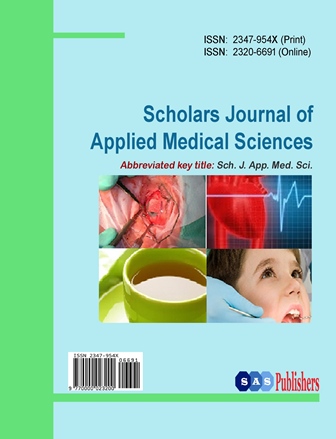+91-9365665504
+91-8724002629
submit@saspublishers.com / saspjournals@gmail.com

An International Publisher for Academic and Scientific Journals
Author Login
Scholars Journal of Applied Medical Sciences
Journal Home
Description
Editorial Board
Archives
Indexing
Statistics
Title : Scholars Journal of Applied Medical Sciences
Abbr : Sch J App Med Sci
ISSN (Online) : 2320-6691
ISSN (Print) : 2347-954X
Discipline : Medical Sciences
Frequency : Monthly
Country : India
Language : English
Abbr : Sch J App Med Sci
ISSN (Online) : 2320-6691
ISSN (Print) : 2347-954X
Discipline : Medical Sciences
Frequency : Monthly
Country : India
Language : English
10.36347/sjams
DOI
DOI
7.5 (ICV: 82.66)
IMPACT FACTOR
IMPACT FACTOR
Current Issue : Volume-13 - Issue-12 ; 2025
Recently Published Articles
Dec. 24, 2025 | Original Research Article
A Cross-Sectional Study to Assess the Effect of Social Support, Hope and Resilience on Quality of Life of Breast Cancer Patients Attending Oncology Units of Selected Hospitals of Bagalkot
Hullur BC, Treesa Joseph, Deelip Somaninga Natekar
Sch J App Med Sci | 2035-2041
DOI : https://doi.org/10.36347/sjams.2025.v13i12.014
Dec. 23, 2025 | Original Research Article
Impact of Oligohydramnios on Fetomaternal Outcome
Dr. Aleya Sultana, Dr. Arifa Zaher, Dr. Debalina Das, Dr. Kamrun Nahar
Sch J App Med Sci | 2029-2034
DOI : https://doi.org/10.36347/sjams.2025.v13i12.013
Dec. 22, 2025 | Original Research Article
Recurrence of Fungal Infection in Rural People in Jashore Medical College Hospital, Bangladesh
Dr. Alok Kumar Sarkar, Dr. Yeasmin, Dr. Joyanto Saha
Sch J App Med Sci | 2022-2028
DOI : https://doi.org/10.36347/sjams.2025.v13i12.012





